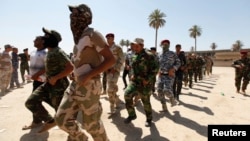The Defense Department confirms it has received the written reports of U.S. teams sent to Iraq to assess the state of the country’s military and security situation. But officials caution it still could take some time before any decision is made on what should happen next.
The assessment from U.S. special forces comes about two weeks after they first set foot in Baghdad, asked to determine how far Iraqi security forces have fallen since American troops pulled out in 2011.
“The initial work is done. Additional assessment work continues. We have not moved to an advisory capacity at this point," said Rear Admiral John Kirby.
Pentagon spokesman Rear Admiral Kirby says U.S. forces have been sharing information with the Iraqis through an operations center in Baghdad and with Kurdish Peshmerga fighters through a center in Irbil. But he says any increase in U.S. assistance will have to wait.
“Everybody knows and shares a sense of urgency about what’s going on in Iraq, but it’s more important to get this issue than to get it quick," said Kirby.
Iraqi officials have been clamoring for more help - including airstikes against ISIL targets - but aside from rifles and ammunition, such help has been slow in coming.
And information in the classified assessment, leaked to the New York Times, may make it even more difficult for the U.S. to take a hands-on approach. It warns many Iraqi units have been compromised, infiltrated by Sunni extremists.
Jessica Lewis is with the Institute for the Study of War.
“One of the considerations needs to be how safely can the U.S. work alongside the Iraqi security forces, given that some of the militias in question are ones that had targeted U.S. soldiers previously?," said Lewis.
The Pentagon’s plans had called for teams in Iraq to reach out to other potentially friendly forces. But while that’s been happening with Kurdish fighters in the north, Pentagon officials say they have not been able to reach out to Shi’ite militias in and around Baghdad, due in large part to heavy Iranian involvement.







